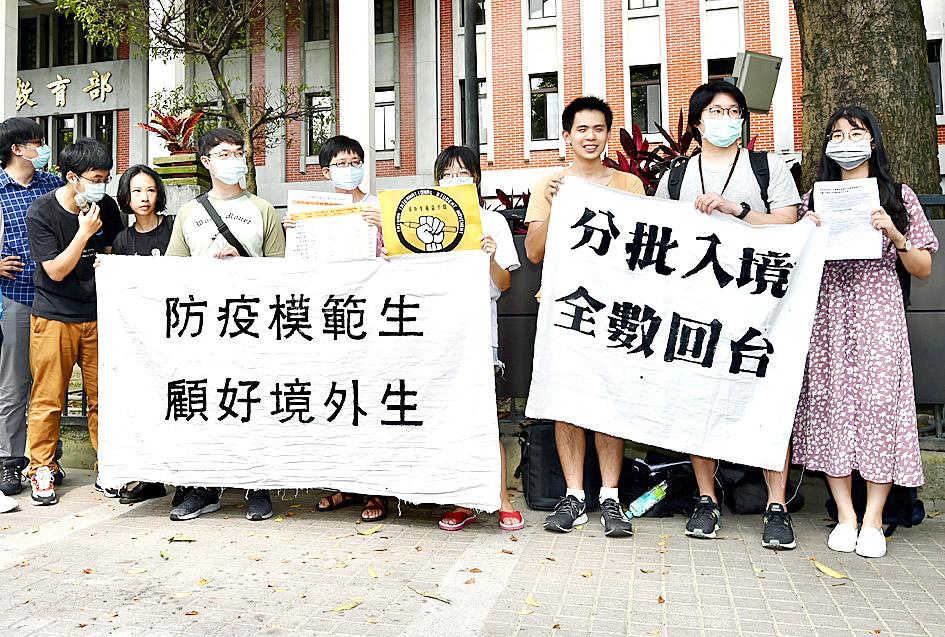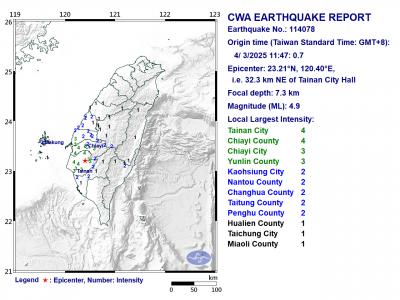Nearly 40 percent of the nation’s imported COVID-19 cases were intercepted at the border, the Central Epidemic Command Center (CECC) said yesterday, adding that maintaining strict border controls remains an important policy.
The center would only consider reopening the border if the nation’s disease situation remains stable after domestic restrictions have been lifted, Minister of Health and Welfare Chen Shih-chung (陳時中), who also heads the center, said at the center’s daily news briefing in Taipei yesterday.
Taiwan on March 19 banned the entry of all foreign nationals, with the exception of Alien Resident Certificate holders, members of diplomatic missions or representative offices, those honoring a business contract, and people granted special permission by Taiwan’s representative office in their home nation.

Photo: Tu Chien-jung, Taipei Times
While the Ministry of Education had proposed that the government allow the entry of overseas students from nations deemed to be less at risk of COVID-19, a Cabinet meeting on Wednesday did not reach a conclusion.
The center would not prioritize the entry of overseas students, Chen said when asked about the issue yesterday.
Those visiting on trade or medical missions are prioritized, he said, adding that special permission is still given on a case-by-case basis.
Given that there is still a need for strict border controls to prevent imported cases, the center, which is operating at level 1, would not be downgraded to level 2 or level 3 for the foreseeable future, Chen said.
The center yesterday did not report any additional COVID-19 cases.
The nation has reported 443 cases with seven fatalities — 352 imported cases, 55 local infections and 36 infections originating from the navy’s “Friendship Flotilla” — while 429 patients have been discharged from hospital after treatment, center data showed.
Of the 352 imported cases, 39 percent, or 138 cases, were intercepted at the border, including the nation’s first confirmed case — a businesswoman flying from Wuhan, China, on Jan. 20, said Deputy Minister of the Interior Chen Tsung-yen (陳宗彥), the center’s deputy head.
Since the coronavirus outbreak began, 6,000 people with possible COVID-19 symptoms have undergone testing at airports and ports, while the center has issued nearly 150,000 home quarantine notices, Chen Tsung-yen said.
The Civil Aeronautics Administration and airlines are discussing adjusting the routes within airports to separate tourists transiting in Taiwan from inbound tourists, Chen Tsung-yen said when asked if the center is planning to lift the ban on flight transfers, which was implemented on March 24.
Whether to lift the ban on flight transfers could be discussed when those plans are ready, Chen Shih-chung said.

‘DENIAL DEFENSE’: The US would increase its military presence with uncrewed ships, and submarines, while boosting defense in the Indo-Pacific, a Pete Hegseth memo said The US is reorienting its military strategy to focus primarily on deterring a potential Chinese invasion of Taiwan, a memo signed by US Secretary of Defense Pete Hegseth showed. The memo also called on Taiwan to increase its defense spending. The document, known as the “Interim National Defense Strategic Guidance,” was distributed this month and detailed the national defense plans of US President Donald Trump’s administration, an article in the Washington Post said on Saturday. It outlines how the US can prepare for a potential war with China and defend itself from threats in the “near abroad,” including Greenland and the Panama

A magnitude 4.9 earthquake struck off Tainan at 11:47am today, the Central Weather Administration (CWA) said. The hypocenter was 32.3km northeast of Tainan City Hall at a depth of 7.3km, CWA data showed. The intensity of the quake, which gauges the actual effect of a seismic event, measured 4 in Tainan and Chiayi County on Taiwan's seven-tier intensity scale, the data showed. The quake had an intensity of 3 in Chiayi City and County, and Yunlin County, while it was measured as 2 in Kaohsiung, Nantou County, Changhua County, Taitung County and offshore Penghu County, the data showed. There were no immediate reports of

The Chinese Nationalist Party (KMT) is maintaining close ties with Beijing, the Democratic Progressive Party (DPP) said yesterday, hours after a new round of Chinese military drills in the Taiwan Strait began. Political parties in a democracy have a responsibility to be loyal to the nation and defend its sovereignty, DPP spokesman Justin Wu (吳崢) told a news conference in Taipei. His comments came hours after Beijing announced via Chinese state media that the Chinese People’s Liberation Army’s Eastern Theater Command was holding large-scale drills simulating a multi-pronged attack on Taiwan. Contrary to the KMT’s claims that it is staunchly anti-communist, KMT Deputy

RESPONSE: The government would investigate incidents of Taiwanese entertainers in China promoting CCP propaganda online in contravention of the law, the source said Taiwanese entertainers living in China who are found to have contravened cross-strait regulations or collaborated with the Chinese Communist Party (CCP) could be subject to fines, a source said on Sunday. Several Taiwanese entertainers have posted on the social media platform Sina Weibo saying that Taiwan “must be returned” to China, and sharing news articles from Chinese state media. In response, the Mainland Affairs Council (MAC) has asked the Ministry of Culture to investigate whether the entertainers had contravened any laws, and asked for them to be questioned upon their return to Taiwan, an official familiar with the matter said. To curb repeated